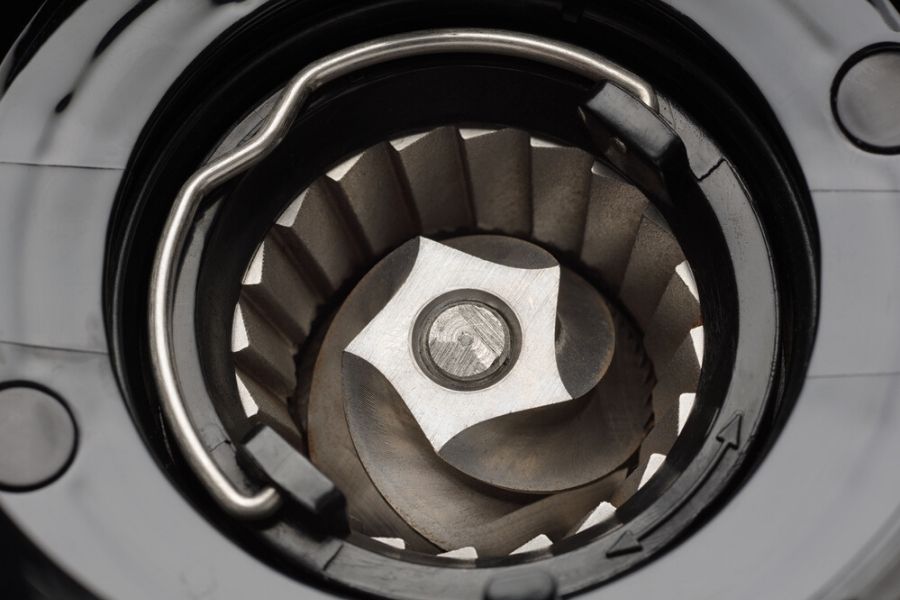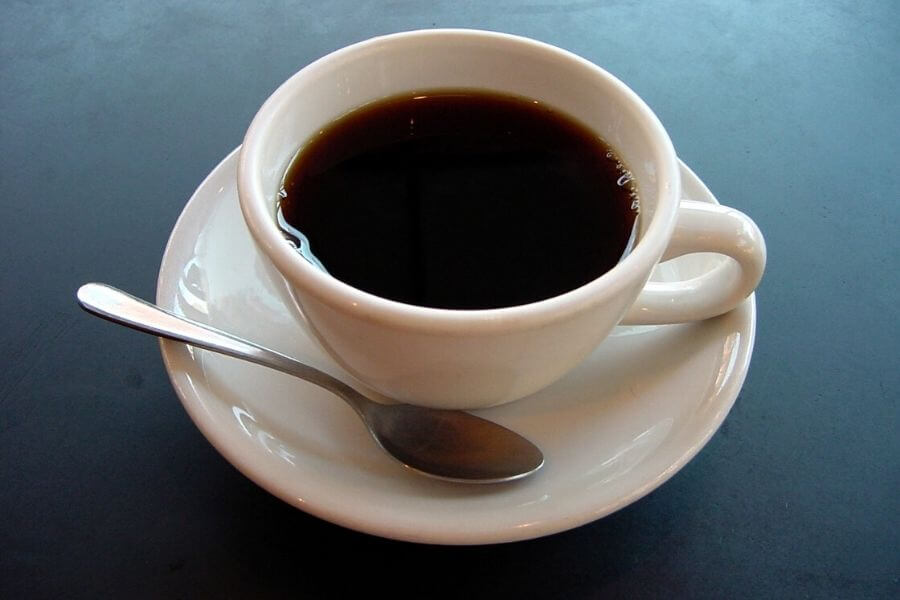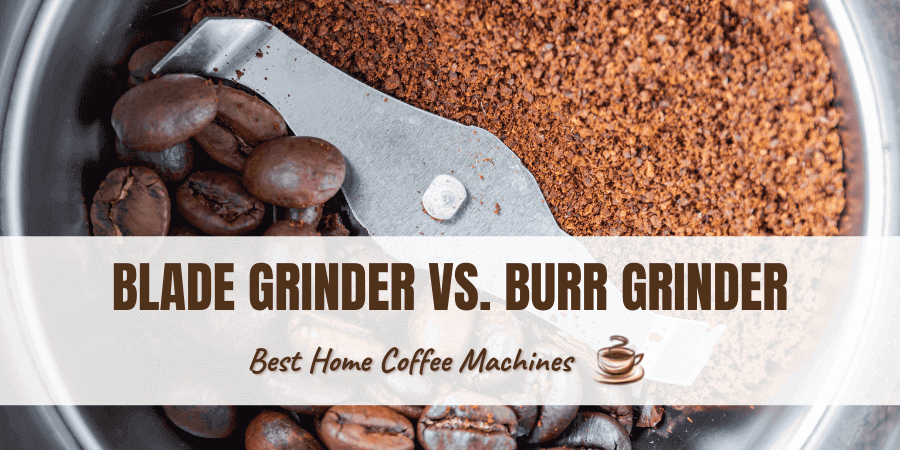Blade Grinder vs. Burr Grinder – What’s the Difference?
If you’re a coffee aficionado, then you understand the importance of grinding coffee beans right before brewing. You’ve probably already heard that there are different types of grinders, but may not know the difference between burr and blade grinders.
In the big picture, there are really only two bean grinders types: burr and blade. Before purchasing either one, it’s important to know that each does its job in different ways.
Which is right for you is largely a matter of want from your java. Blade grinders are simpler, smaller, and less expensive. Burr coffee grinders have more options but cost more.
What we’ll cover here:
What Is a Blade Coffee Grinder?
Blade coffee grinders are small and inexpensive electric devices. A double-pronged stainless steel blade spins in the bottom of the device, and when we say “spin,” we mean it spins. Some appliances operate at more than 10,000 revolutions per minute (rpm).
A blade grinder works by slicing beans as its blade spins. While this type of device is quick, it’s not always consistent. Due to the design, some beans will be sliced more than others, which often results in grinds that are unevenly sized.
Blade coffee grinders usually have a single setting, so getting the appropriate grind for a particular coffee type (French press or moka pot, for example), can require some experimentation. That said, if the beans haven’t been ground finely enough, you can simply repeat the process. But note that the more you grind, the hotter the beans become, which affects the flavor profile.
Because of the heat generated by a blade grinder, using short bursts to grind beans is recommended. A blade coffee grinder’s time limit is usually less than 30 seconds of continuous use. Many models have auto-shutoff features that prevent overheating.

Explore our favorite blade coffee grinders here:
How Does a Burr Grinder Work?
Burr coffee grinders feature two revolving burrs that crush beans, rather than slicing them. They come in both electric and manual versions. Burr grinders often have multiple grind-level settings and easily produce grinds for espresso to French press and everything in between.
Because they may have numerous settings, these devices can appear more complicated than blade grinders. However, some burr grinders are very user-friendly, even if you’ve never ground your own coffee beans before.
Most burr coffee grinders don’t generate as much heat as blade coffee grinders as they grind at slower speeds. They’re typically more expensive than blade grinders. Burr grinders use either conical or flat burrs made of stainless steel or ceramic.
Conical Burrs
Conical burrs naturally resist heat and don’t require as much energy as flat burrs. There is a center, cone-shaped burr, and a serrated outer burr which work together to grind beans vertically.
While conical burr grinders do a decent job of producing even grinds, they’re not as consistent as flat burr coffee grinders. However, conical burrs are quieter and generally less expensive than flat burrs.
Flat Burrs
Flat burrs are considered the preferred type for burr coffee grinders. Two rings with serrated teeth lie against each other and grind beans horizontally, rather than vertically.
Flat burrs do create more heat but result in grinds of the most consistent size and texture. With a flat burr grinder, fewer grinds get stuck inside the grinder, which means cleaning the device can be simpler. However, they are noisier and more expensive than conical burr models.

Take a look at our favorite burr coffee grinders:
Blade Grinder vs. Burr Grinder: Is One Better Than the Other?
Most java professionals will tell you a burr grinder is always better than a blade grinder, and burr devices have long been considered the gold standard.
But there’s no universal answer that suits everyone, and which is right for you really comes down to your own needs. Below is a quick round-up of the differences and an overview of the pros and cons of burr and blade grinders.
Simplicity
Burr coffee grinders, with the exception of manual devices, are often more complex than blade grinders. Just having more grind settings automatically makes a burr coffee grinder less straightforward than a blade version as these only have one setting.
However, you’ll have to experiment to figure out the perfect grind for your preferred beverage. With a burr grinder, choosing a grind setting is easier and some models can even be programmed. Simply touch a button and the device automatically churns out perfect grinds.
Price Tag
Burr coffee grinders are generally more expensive than blade grinders; all those programmable options cost after all! Blade grinders, on the other hand, are affordable, making them ideal for bean lovers on a tight budget or those just getting started on their craft coffee journey.
Consistency and Effect on Coffee
When it comes to consistency, there really is no competition — burr coffee grinders produce even, smooth grinds of a consistent size. Yes, this can be achieved with most blade coffee grinders, but it’s much more difficult and requires a lot of practice.
It might seem like such a small matter, but grind size and consistently can have big effects. That’s because the extraction rate of coffee grounds rises when there’s a larger surface area. To increase this surface area, you’ll want to grind the coffee finer. Accordingly, the higher the extraction rate, the less contact time the grinds need with hot water.
Consistent coffee grinds ensure that your coffee tastes exactly as expected, from the first sip to the last drop in your cup. With inconsistent grinds, your cup of joe may not have the flavor you’re hoping for.
Heat can also affect how your java tastes. Blade coffee grinders often produce more heat, which can negatively impact how the beans taste. Because of their design, burr coffee grinders don’t generate as much heat against the coffee beans, so their taste will be exactly what you expect.
Grinding for Different Kinds of Coffee
Again, the answer is pretty clear. If you only drink one style of java, then a blade coffee grinder could do exactly what you need it to do. However, since these have one single setting only, it’s difficult to grind beans for multiple kinds of coffee. It can be done, by repeatedly grinding beans for example, but that will take more time and effort.
Burr coffee grinders usually have multiple grind level settings. In fact, some models have 20 or more different options, which makes these grinders ideal for people who like to drink different types of coffee. It’s relatively simple to grind beans for espresso one day and pour-over java the next.

So Which One Is Best?
Some people find that a blade coffee grinder does everything they need it to do, while others prefer the options burr grinders offer. If your budget is strict, you don’t drink a variety of coffee types, or if there’s minimal space on your kitchen counter, then a blade grinder is for you.
However, if that’s not you, go ahead and get that burr coffee grinder. You’ll get a machine with more options and better quality, plus your java will thank you for it.
Conclusion
Circling back to the original topic of blade grinder vs. burr grinder, as we’ve seen, there’s no real right or wrong answer. Each type has its place, and coffee lovers fall on both sides of the debate.
Blade coffee grinders work well if you’re looking for something that’s small and convenient. They can even double as spice or nut grinders, although we recommend purchasing a separate grinder, unless you like java with a slight nutmeg flavor!
But are burr coffee grinders better? Yes, burr grinders almost always win in terms of quality, they simply do a better job.
Do you have a preference for one over the other? Let me know which one you like best in the comments!
Burr vs. Blade Grinder FAQs
Are Coffee Grinders Worth It?
Absolutely, yes! Freshly ground coffee beans are the secret to a great cup of java, and grinding your own beans is always better than using pre-ground stuff.
Why Is a Burr Grinder Better Than a Blade Grinder for Coffee?
The main reason is that burr coffee grinders produce a more uniform, consistent grind than blade grinders. Uneven grinds that aren’t smooth can negatively affect your beverage’s taste.
Are Blade Coffee Grinders Really That Bad?
It’s not so much that they’re bad, but they’re just not as good as burr coffee grinders. Burr grinders do a better job with coffee beans, but blade grinders are smaller and usually cheaper, so they might be a better option for some people.
Why Are Burr Grinders So Expensive?
You’re paying for a better design with better quality construction. Burr grinders are usually larger and include ceramic or stainless steel burrs, which cost more to produce.
How Much Should I Spend on a Coffee Grinder?
You can reasonably expect to pay at least $30 or $40 for a quality blade coffee grinder. For a quality burr grinder, you can expect to pay at least $100.





